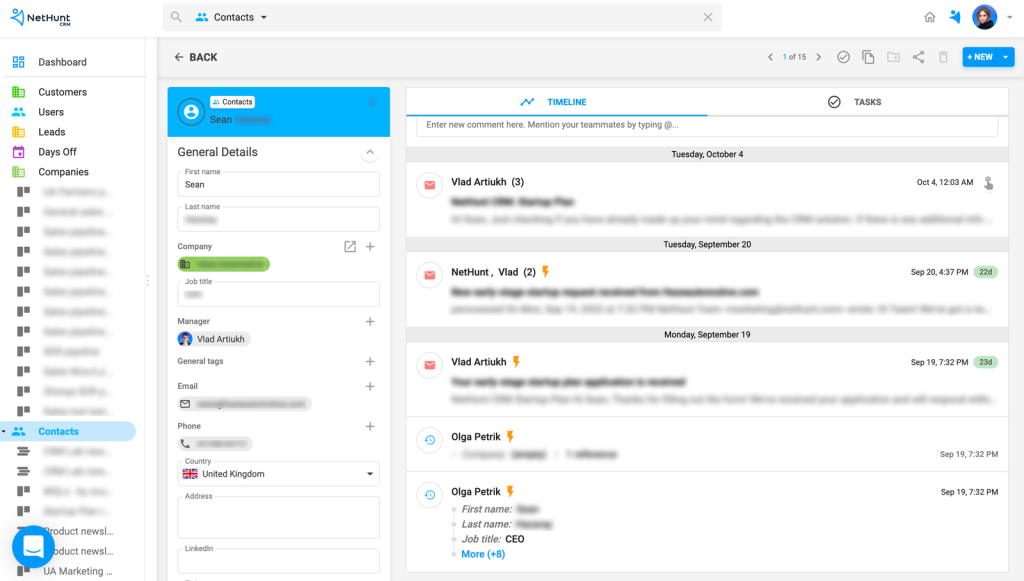Capturing and nurturing leads is an essential aspect of any online business. Yet, not every lead can be successfully converted into a customer using the same approach and tactics. That’s why having an insight into the lead’s quality can greatly impact your outcomes and conversion rates. So, what is lead segmentation, and how can it improve your overall lead-generation process?
We’ll provide a detailed overview of this process and elaborate on the different types of lead segmentation and their key aspects. Continue reading to discover how to segment leads and the best practices when categorizing your target audience!
What Is Lead Segmentation?
Lead segmentation is categorizing your potential customers into distinct, smaller groups based on previously defined criteria. It helps you better understand your target audience and allows you to create a tailored and personalized approach based on the group’s activities, characteristics, behaviors, and interests.
While many businesses often view their audience as numbers, it’s important to remember that you’re dealing with real-life people, each with unique needs and expectations. So, trying to nurture your leads with a generic message without addressing unique circumstances can negatively impact your online success and conversion rates.
However, by optimizing this segmentation process, you can craft comprehensive marketing strategies to address each customer group based on their characteristics. This personalized approach will help you determine who is most interested in your offers and improve your profitability and ROI.
Types of Lead Segmentation
You can utilize different types of lead segmentation methods based on your unique business goals. Some of the most common options are the following:
- Demographic segmentation: Focuses on the target audience’s demographic information, including factors such as age, gender, education level, marital status, income, and occupation.
- Geographic segmentation: Based on their geographic and physical location. Some of the factors within this category are the country, region, city, or neighborhood. You can also include the population density, climate, and cultural preferences.
- Behavioral segmentation: Focuses on the audience’s behavior and interactions with your business. Some common actions based on which this target group is categorized are the purchase history and patterns, product knowledge, usage rates and awareness levels, online behavior, and response to previous marketing campaigns.
- Psychographic segmentation: Based on the audience’s lifestyle choices, psychological traits, and values. To successfully personalize your lead generation efforts based on this customer group, you must understand their interests, attitudes, personality, and desires.

Benefits of Lead Segmentation
Now that you’re well-acquainted with the use and types of lead segmentation, we want to focus on why it plays a vital role in your lead generation effort. Some of the key benefits you can expect by optimizing this process are the following:
- Improved targeting and relevance
- Enhanced lead nurturing
- Increased conversion rates
- Better resource allocation
- Strengthened customer relationships
Improved targeting and relevance
Businesses turn to lead segmentation for improved targeting and relevance. Dividing leads into smaller groups can provide insights into how to develop more personal and highly targeted marketing campaigns that address the needs of specific customer groups. By tailoring your offers to resonate with a specific lead segment, the message you try to convey will be more effective and relevant.
Enhanced lead nurturing
Since the segmentation process results in more personalized communication, it can drastically improve your lead-nurturing efforts. By addressing the needs and challenges of your target audience, you can encourage them to move down the sales funnel and make a purchase. You can also modify your nurturing approach to meet the needs of the prospects you have identified as most and least likely to convert.
Increased conversion rates
An optimized lead segmentation strategy inevitably leads to increased conversion rates. By optimizing your content based on the user’s needs and providing a positive user experience, you’ll notice that people are more likely to convert into paying customers.
Moreover, you may successfully direct leads down the sales funnel by customizing your techniques to their preferences. You also benefit from knowing which leads will most likely purchase your product or service.
Better resource allocation
Even though it’s often overlooked, one key benefit of lead segmentation is better resource allocation. Knowing which marketing and sales efforts work best for your leads can help you achieve a higher return on investment (ROI). Once again, you can allocate more resources to high-value segments that are more likely to convert and maximize your revenue and business growth.
Strengthened customer relationships
The last benefit you can expect from implementing lead segmentation into your daily operations is strengthened customer relationships. As mentioned, dividing your leads into separate segments can help create personalized approaches based on their needs. You can build strong, long-lasting relationships with potential customers instead of a generic message and increase engagement.
Factors to Consider in Lead Segmentation
As with any business operation, there are several factors you should consider when implementing a lead segmentation strategy. The ones that have the biggest impact on your outcomes are the following:
- Business goals
- Data quality
- Flexibility
- Software and tools
Business goals
First, you should always ensure your segmentation criteria are relevant to your business goals. By defining which objectives you want to focus on, you can determine the metrics that best suit your segmentation needs.
Whether you’re looking to increase sales, improve your customer retention, or enhance the overall user experience, these metrics will help you measure the success of your efforts. They will also help you determine if there are any adjustments you should make to meet your goals.
Data quality
Next, you should ensure the quality and accuracy of your data sources. By ensuring your segmentation process relies on the latest data, you can prevent faulty segmentation and improper resource allocation.
Furthermore, the data you use during this process should always be complete. Missing crucial information will make it difficult to understand your audience and craft a personalized approach.
Flexibility
Another important factor you should consider is the adaptability of segmentation strategies. Remember that the online market is ever-evolving, with frequent changes in technological advancements, customer preferences, and industry conditions.
That said, focusing on continuous improvement and data-based adjustments is key to optimizing the lead segmentation process. This ensures positive results in the long run.
Software and tools
Lastly, remember that integrating CRM systems and marketing automation tools can help you stay organized and optimize your segmentation efforts. Since these tools have multiple features regarding data, analytics, and automation, you can use them to create and manage your segmentation strategies to drive better results. Most of these platforms offer better lead scoring due to their behavior tracking and prioritization capabilities.

Best Practices for Implementing Lead Segmentation
Now that you’ve grasped the basics of lead segmentation, we want to highlight some of the best practices surrounding this process. To ensure optimal results when segmenting your audience, here’s what you should focus on:
Segmentation criteria
Before categorizing your target audience into smaller groups, you should define clear segmentation criteria based on their characteristics. As mentioned, this can be based on the users’ demographic, behavioral, psychographic, and geographic information. You can also base your segmentation process on the audience’s engagement level to determine which leads are more likely to convert.
Data analytics
Data analytics and ideal customer insights can help you better understand your lead segmentation efforts. Focusing on data regarding your segmentation effectiveness can help predict future trends and forecasting, improving your overall targeting and strategies. Many businesses use real-time analytics and data visualization for a comprehensive process overview to ensure positive outcomes and business growth.
Data-driven decisions
Monitoring and refining your segmentation strategies based on performance metrics can help you make data-driven decisions and achieve better results. Having insight into the key areas of improvement and pain points allows you to identify and implement proactive strategies that ensure online success.
Challenges and Limitations of Lead Segmentation
We’d also like to discuss common challenges and limitations you should consider. Familiarizing yourself with these risks beforehand can help you better prepare for your challenges and develop suitable strategies to counter them. That being said, here are the main limitations of lead segmentation and how to address them:
- Complexity of the segmentation process
- Over-segmentation and under-segmentation risks
- Data privacy and compliance concerns
- Accurate segmentation in dynamic markets
Complexity of the segmentation process
The main challenge in lead segmentation is the complexity of the process. As mentioned, developing a successful segmentation strategy requires thorough research and planning.
Besides dealing with large volumes of data on which you base your decisions, you must also be aware of the ever-evolving market and its changes. Furthermore, you must ensure proper resource allocation and flawless integration with your other marketing strategies.
You need to monitor your efforts and adopt the tools and software to overcome these challenges. Moreover, you must have an experienced team that stays up-to-date with the latest developments and technologies. That’s why many businesses turn to outsourcing services to gain access to experts and their innovative tools.
Over-segmentation and under-segmentation risks
Another common challenge you should be mindful of is the risk of over-segmentation and under-segmentation. While over-segmentation results from creating too many segmentation groups, under-segmentation is caused by insufficient segments.
Initially, having too many smaller groups can make it harder to manage your campaigns and develop unique personalized approaches for each group. It also makes tracking your performance and allocating your resources harder.
On the other hand, under-segmentation can result in overly broad segments, leading to generic marketing efforts and lower engagement levels. You can also miss many opportunities due to a lack of diversity, personalization, and inaccurate targeting.
Data privacy and compliance concerns
The next lead segmentation challenge you should be aware of revolves around data privacy and compliance concerns. This includes how you collect, process, and use the gathered data.
However, since you’ll be dealing with private user information, you must comply with strict regulatory standards, such as the GDPR (General Data Protection Regulation) and CCPA (California Consumer Privacy Act). Failing to do so can result in various penalties and fines that can affect your organization’s reputation and financial health.
Accurate segmentation in dynamic markets
Lastly, many businesses face difficulty in achieving accurate segmentation in dynamic markets. As mentioned, many industries are subjected to rapid and frequent market trends and consumer behavior changes. So, if a certain strategy used to work before, it’s not guaranteed to drive the same results later.
As new products and services enter the market, the user’s needs and expectations are only expected to change. Also, the online world has always been competitive, so you must prepare that new competitors can easily shift customer loyalty and preferences.

Conclusion
After discovering what is a lead segmentation and how to successfully divide your target audience into smaller groups, remember that you should have predefined goals and criteria on which you’ll base this process. But you must consider the factors influencing the success of this process and try out some of the best practices we’ve mentioned in this article.
As effective lead generation requires time and effort, we want to help businesses access the right audience actively looking for the products and services they offer. That’s why our latest venture, CLICKVISION Lead Gen, focuses on connecting companies with industry-specific, high-quality leads by using inbound lead generation through SEO.
So, contact us today and discover how our services can help you increase your conversion rates and online sales!

Dimitar is a seasoned marketing specialist and the visionary behind CLICKVISION. With over 10 years in digital marketing, he excels in crafting marketing strategies that boost rankings, which in return increase leads, conversions, sales, profits, and ROI.
